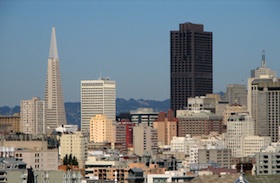BLOOMINGTON, Ind. — The U.S. and Canada Green City Index, part of a research project conducted by research and analysis firm Economist Intelligence Unit, recently released a ranking of cities throughout North America by environmental performance, naming San Francisco as the greenest city.
The survey was commissioned by electronics and electrical engineering firm Siemens Corporation, with a U.S. base in Washington D.C., and evaluated 27 cities based on 31 indicators, ranging from water and energy consumption and conservation to public use of land, public transportation quality and efficiency, and how “walkable” the city is, according to the Sustainability Dashboard.

Researchers said that although some cities were expected to top the list, others came as a surprise.
After San Francisco, the top five ranked cities were Vancouver, New York City, Seattle, and Denver.
Sustainability Dashboard officials said that although some may be surprised New York City made the top five, its public transportation, “walkability” — including its pedestrian zone and efficient land-use program — earned it high marks.
The five least green cities in North America were, in order of ranking, Detroit, St. Louis, Cleveland, Phoenix, and Pittsburgh.
Officials said that some of the least green cities on the list are former manufacturing centers that have been on the decline for years — amplified by the recession.
A statement from the company said that although no federal climate policy or carbon standard exists in the U.S., 21 of the 27 cities in the index have already set their own carbon reduction targets and are creating comprehensive sustainability plans and using current technology.
Key findings noted by Siemens officials revealed that cities which performed best in the rankings are the ones with comprehensive sustainability plans that encompass every aspect of creating a greener future, including transportation, land use, energy use, carbon dioxide emissions, and water.
While there is a correlation between wealth and environmental performance, it is weaker in the U.S. and Canada than in Europe and Asia, the company statement said.
The index, which is the fifth study in the series, was announced at the 2011 Aspen Ideas Festival. Other indices in the series cover Europe, Latin America, Asia, and Germany.
“City budgets are as tight as they have ever been, but mayors are leading the charge around making their cities more sustainable because they know they can’t afford to push these decisions off until tomorrow,” said Alison Taylor, chief sustainability officer for the Americas, Siemens Corp. “Our goal with the Green City Index is to identify best practices, advance good ideas, and provide a baseline for cities to help them set targets for themselves so that they can serve as role models for others with their innovative policies.”
Kaid Benfield, director of the Sustainable Communities and Smart Growth program at the Natural Resources Defense Council and co-founder of the LEED for Neighborhood Development rating system and of the Smart Growth America program, reviewed the survey, commenting that while the authors of the study made an earnest attempt to be fair and accurate, it is really difficult to measure important issues by using only a few simple indicators.
“Probably the worst example of coming up with results that can be misleading is ranking LA near the top for air quality,” he said. “That would certainly come as a surprise to people who breathe the air and the doctors and hospitals that treat them.”
Benfield also said the study’s use of acreage of protected land as a portion of overall land may not be the best indicator of land use at all.
While cities need parks, Benfield said that what may be moreimportant would be to have smaller parks within walking distance of residents rather than large parks that drive up the acreage numbers.
“What really matters to land use is whether neighborhoods are complete, for example whether you can go to the dry cleaner’s or convenience store without getting in your car,” he said. “As Walk Score proves, different cities perform differently on that measure, but the study unfortunately didn’t look at that.”
Overall Rankings, Greenest to Least Green:
1. San Francisco
2. Vancouver
3. New York
4. Seattle
5. Denver
6. Boston
7. Los Angeles
8. Washington, D.C.
9. Toronto
10. Minneapolis
11. Chicago
12. Ottawa
13. Philadelphia
14. Calgary
15. Sacramento
16. Houston
17. Dallas
18. Orlando
19. Montreal
20. Charlotte
21. Atlanta
22. Miami
23. Pittsburgh
24. Phoenix
25. Cleveland
26. St. Louis
27. Detroit
1. San Francisco
2. Vancouver
3. New York
4. Seattle
5. Denver
6. Boston
7. Los Angeles
8. Washington, D.C.
9. Toronto
10. Minneapolis
11. Chicago
12. Ottawa
13. Philadelphia
14. Calgary
15. Sacramento
16. Houston
17. Dallas
18. Orlando
19. Montreal
20. Charlotte
21. Atlanta
22. Miami
23. Pittsburgh
24. Phoenix
25. Cleveland
26. St. Louis
27. Detroit

